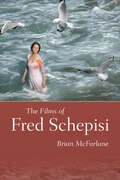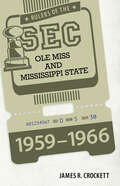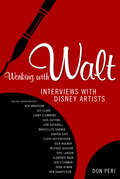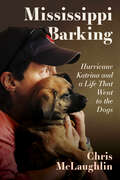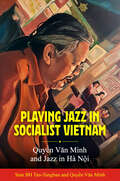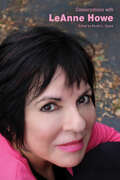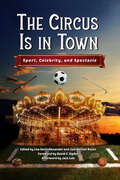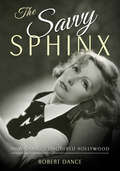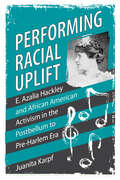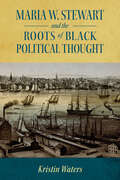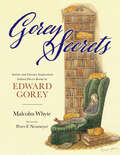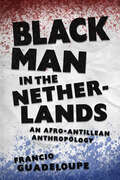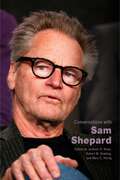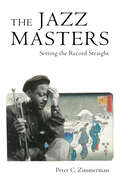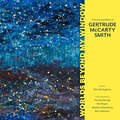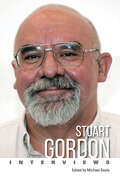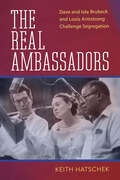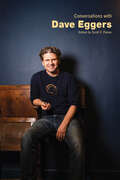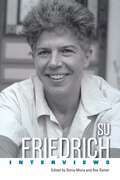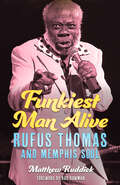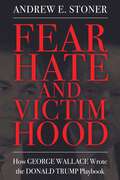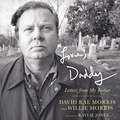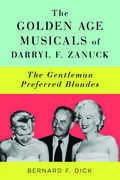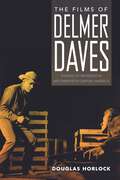- Table View
- List View
The Films of Fred Schepisi
by Brian McFarlaneFred Schepisi is one of the crucial names associated with the revival of the Australian film industry in the 1970s. The Films of Fred Schepisi traces the lead-up to his critical successes in feature filmmaking, via his earlier award-winning success as a producer in advertising commercials in the 1960s and the setting up of his own company. Unlike some directors, he derived from this experience a sure sense of the commercial aspects of filmmaking, as well as its aesthetic considerations. The volume also considers stories of his early education in a Catholic seminary, which he drew on in his semiautobiographical film, The Devil’s Playground, the success of which launched him as an exciting new feature director. The volume expands on Schepisi’s success story to chart his development as a director in demand in other countries, notably in the US and the UK, as well as continuing to make major films in Australia. Brian McFarlane argues that Schepisi’s career is symptomatic of Australian directors who have made their presences felt on the international stage. Whereas other key directors of the Australian film revival, such as Peter Weir and Bruce Beresford, have been the subject of book-length critical studies, Schepisi’s career has not to-date been so explored. McFarlane takes a critical account of Schepisi’s film output—including such standouts as The Chant of Jimmie Blacksmith, Plenty, Roxanne, Six Degrees of Separation, Mr. Baseball, and Last Orders—and he augments analysis with interviews with the director. By discussing the production histories and both critical and popular receptions, McFarlane’s study shines a new light on Schepisi’s work and his rise to prominence in the global film industry.
Rulers of the SEC: Ole Miss and Mississippi State, 1959-1966
by James R. CrockettDuring the years 1959–1966 Mississippi universities dominated the Southeastern Conference (SEC) in the big three sports—basketball, baseball, and football. Of the twenty-four championships that could be earned in those sports, University of Mississippi (Ole Miss) won six and Mississippi State University (MSU) won six. That is, the two Mississippi universities won twelve of the championships. That left the remaining twelve championships for the other members of the conference. Picking up in the late fifties, James Crockett explores the most decisive wins in each major sport, beginning at the source of these victories: the extraordinary coaches and their interesting personalities. With each year, Crockett charts the unreal rise within the SEC conference and the many hardships that faced these beloved teams as their students, faculty, and traditions changed all around them. Stars and coaches that shine in the book include John Vaught, Tom Swayze, Jake Gibbs, and Donnie Kessinger from Ole Miss; and Paul Gregory, Bailey Howell, Babe McCarthy, and the amazing SEC Champion Bulldog basketball team of 1962–1963. Rulers of the SEC: Ole Miss and Mississippi State, 1959–1966 enraptures readers with harrowing victories and multiyear, dynastic championships. It is a tale of great coaches, great athletes, and great teams as they adapted to a controversial era of college sports.
Working with Walt: Interviews with Disney Artists
by Don PeriThis book includes interviews with Ken Anderson, Les Clark, Larry Clemmons, Jack Cutting, Don Duckwall, Marcellite Garner, Harper Goff, Floyd Gottfredson, Dick Huemer, Wilfred Jackson, Eric Larson, Clarence Nash, Ken O'Connor, Herb Ryman, and Ben Sharpsteen. Walt Disney created or supervised the creation of live-action films, television specials, documentaries, toys, merchandise, comic books, and theme parks. His vision, however, manifested itself first and foremost in his animated shorts and feature-length cartoons, which are loved by millions around the world. Working with Walt: Interviews with Disney Artists collects revealing conversations with animators, voice actors, and designers who worked extensively with Disney during the heyday of his animation studio. The book includes fifteen interviews with artists who directed segments of such classic animated features as Dumbo and Fantasia. Some interviewed were part of Disney’s famed team dubbed “The Nine Old Men of Animation,” and some worked closely with Disney on Steamboat Willie, his first cartoon with sound. Among the subjects the interviewees discuss are the studio’s working environment, the high-water mark of animation during Hollywood's Golden Age, and Disney’s mixture of childlike charm and hard-nosed business drive. Through these voices, Don Peri preserves an account of the Disney magic from those who worked closely with him.
Mississippi Barking: Hurricane Katrina and a Life That Went to the Dogs
by Chris McLaughlinWinner of a 2023 Best Book Award in the category of Animals/Pets: Narrative Nonfiction from American Book FestOn August 29, 2005, the worst natural disaster in the history of the United States devastated the city of New Orleans and the Gulf Coast of Louisiana and Mississippi. Like many others in America and around the world, Chris McLaughlin watched the tragedy of Katrina unfold on a television screen from the comfort of her living room on Cape Cod in Massachusetts. In the devastation afterwards, almost 2,000 people and an estimated 250,000 animals had perished. Miraculously, many pets did manage to survive. But in the months that followed the hurricane, thousands of them were fending for themselves in the ruins of devastated neighborhoods. They roamed the streets in feral packs or struck out alone. Their plight triggered a grassroots rescue effort unlike any this country had ever seen, and while relief organizations such as the Red Cross were tending to the human survivors, and movie stars and celebrities were airlifting food and endorsing seven-figure checks, a much smaller and meagerly funded effort was underway to save the four-legged victims. With no prior experience in disaster response and no real grasp of the hell that awaited them, scores of animal lovers, including McLaughlin, made their way to the Gulf Coast to help in any way they could. Including photos from four-time Pulitzer Prize–winning photojournalist Carol Guzy, Mississippi Barking spans the course of two years as McLaughlin and others ventured into the wreckage of the Gulf Coast to rescue the animals left behind. McLaughlin tells the moving stories of the people she met along the way, both those who lost everything to the hurricane and those working beside her rescuing and transporting animals away from the neglected, derelict conditions in which they barely survived. Within this story of tragedy and cruelty, suffering and ignorance, Mississippi Barking also bears witness to selfless acts of bravery and compassion, and the beauty and heroics of those who risked everything to save the animals that could not save themselves.
Playing Jazz in Socialist Vietnam: Quyền Văn Minh and Jazz in Hà Nội
by Stan BH Tan-Tangbau Văn Minh QuyềnShortlisted for the EuroSEAS Humanities Book Prize 2022Quyền Văn Minh (b. 1954) is not only a jazz saxophonist and lecturer at the prestigious Vietnam National Academy of Music, but he is also one of the most preeminent jazz musicians in Vietnam. Considered a pioneer in the country, Minh is often publicly recognized as the “godfather of Vietnamese jazz.” Playing Jazz in Socialist Vietnam tells the story of the music as it intertwined with Minh’s own narrative. Stan BH Tan-Tangbau details Minh’s life story, telling how Minh pioneered jazz as an original genre even while navigating the trials and tribulations of a fervent socialist revolution, of the ideological battle that was the Cold War, of Vietnam’s war against the United States, and of the political changes during the Đổi Mới period between the mid-1980s and the 1990s. Minh worked tirelessly and delivered two breakthrough solo recitals in 1988 and 1989, marking the first time jazz was performed in the public sphere in the socialist state. To gain jazz acceptance as a mainstream musical art form, Minh founded Minh Jazz Club. With the release of his debut album of original compositions in 2000, Minh shaped the nascent genre of Vietnamese jazz. Minh’s endeavors kickstarted the momentum, from his performing jazz in public, teaching jazz both formally and informally, and contributing to the shaping of an original Vietnamese voice to stand out among the many styles in the jazz world. Most importantly, Minh generated a public space for musicians to play and for the Vietnamese to listen. His work eventually helped to gain jazz the credibility necessary at the national conservatoire to offer instruction in a professional music education program.
Conversations with LeAnne Howe (Literary Conversations Series)
by Kirstin L. SquintConversations with LeAnne Howe is the first collection of interviews with the groundbreaking Choctaw author, whose genre-bending works take place in the US Southeast, Oklahoma, and beyond our national borders to bring Native American characters and themes to the global stage. Best known for her American Book Award–winning novel Shell Shaker (2001), LeAnne Howe (b. 1951) is also a poet, playwright, screenwriter, essayist, theorist, and humorist. She has held numerous honors including a Fulbright Distinguished Scholarship in Amman, Jordan, from 2010 to 2011, and she was the recipient of the Modern Language Association’s first Prize for Studies in Native American Literatures, Cultures, and Languages for her travelogue, Choctalking on Other Realities (2013).Spanning the period from 2002 to 2020, the interviews in this collection delve deeply into Howe’s poetics, her innovative critical methodology of tribalography, her personal history, and her position on subjects ranging from the Lone Ranger to Native American mascots. Two previously unpublished interviews, “‘An American in New York’: LeAnne Howe” (2019) and “Genre-Sliding on Stage with LeAnne Howe” (2020), explore unexamined areas of her personal history and how it impacted her creative work, including childhood trauma and her incubation as a playwright in the 1980s. These conversations along with 2019’s Occult Poetry Radio interview also give important insights on the background of Howe’s newest critically acclaimed work, Savage Conversations (2019), about Mary Todd Lincoln’s hallucination of a “Savage Indian” during her time in Bellevue Place sanitarium. Taken as a whole, Conversations with LeAnne Howe showcases the development and continued impact of one of the most important Indigenous American writers of the twenty-first century.
The Circus Is in Town: Sport, Celebrity, and Spectacle
by Jack LuleContributions by Lisa Doris Alexander, Matthew H. Barton, Andrew C. Billings, Carlton Brick, Ted M. Butryn, Brian Carroll, Arthur T. Challis, Roxane Coche, Curtis M. Harris, Jay Johnson, Melvin Lewis, Jack Lule, Rory Magrath, Matthew A. Masucci, Andrew McIntosh, Jorge E. Moraga, Leigh M. Moscowitz, David C. Ogden, Joel Nathan Rosen, Kevin A. Stein, and Henry YuIn this fifth book on sport and the nature of reputation, editors Lisa Doris Alexander and Joel Nathan Rosen have tasked their contributors with examining reputation from the perspective of celebrity and spectacle, which in some cases can be better defined as scandal. The subjects chronicled in this volume have all proven themselves to exist somewhere on the spectacular spectrum—the spotlight seemed always to gravitate toward them. All have displayed phenomenal feats of athletic prowess and artistry, and all have faced a controversy or been thrust into a situation that grows from age-old notions of the spectacle. Some handled the hoopla like the champions they are, or were, while others struggled and even faded amid the hustle and flow of their runaway celebrity. While their individual narratives are engrossing, these stories collectively paint a portrait of sport and spectacle that offers context and clarity. Written by a range of scholarly contributors from multiple disciplines, The Circus Is in Town: Sport, Celebrity, and Spectacle contains careful analysis of such megastars as LeBron James, Tonya Harding, David Beckham, Shaquille O’Neal, Maria Sharapova, and Colin Kaepernick. This final volume of a project that has spanned the first three decades of the twenty-first century looks to sharpen questions regarding how it is that reputations of celebrity athletes are forged, maintained, transformed, repurposed, destroyed, and at times rehabilitated. The subjects in this collection have been driven by this notion of the spectacle in ways that offer interesting and entertaining inquiry into the arc of athletic reputations.
The Savvy Sphinx: How Garbo Conquered Hollywood
by Robert DanceNamed a 2022 Richard Wall Award Finalist by the Theatre Library AssociationFrom the late 1920s through the thirties, Greta Garbo (1905–1990) was the biggest star in Hollywood. She stopped making films in 1941, at only thirty-six, and thereafter sought a discreet private life. Still, her fame only increased as the public and press clamored for news of the former actress. At the time of her death, forty-nine years later, photographers continued to stalk her, and her death was reported on the front pages of newspapers worldwide. In The Savvy Sphinx: How Garbo Conquered Hollywood, Robert Dance traces the strategy a working-class Swedish teenager employed to enter motion pictures, find her way to America, and ultimately become Hollywood’s most glorious product. Brilliant tactics allowed her to reach Hollywood’s upper-most echelon and made her one of the last century’s most famous people. Garbo was discovered by director Mauritz Stiller, who saw promise in her nascent talent and insisted that she accompany him when he was lured to America by an MGM contract. By twenty she was a movie star and the epitome of glamour. Soon Garbo was among the highest-paid performers, and in many years she occupied the number one position. Unique among studio players, she quickly insisted on and was granted final authority over her scripts, costars, and directors. But Garbo never played the Hollywood game, and by the late twenties her unwillingness to grant interviews, attend premieres, or meet visiting dignitaries won her the sobriquet the Swedish Sphinx. The Savvy Sphinx, which includes over a hundred beautiful images, charts her rise and her long self-imposed exile as the queen who abdicated her Hollywood throne. Garbo was the paramount star produced by the Hollywood studio system, and by the time of her death her legendary status was assured.
Performing Racial Uplift: E. Azalia Hackley and African American Activism in the Postbellum to Pre-Harlem Era (Margaret Walker Alexander Series in African American Studies)
by Juanita Karpf2023 CHOICE Outstanding Academic TitleIn Performing Racial Uplift: E. Azalia Hackley and African American Activism in the Postbellum to Pre-Harlem Era, Juanita Karpf rediscovers the career of Black activist E. Azalia Hackley (1867–1922), a concert artist, nationally famous music teacher, and charismatic lecturer. Growing up in Black Detroit, she began touring as a pianist and soprano soloist while only in her teens. By the late 1910s, she had toured coast-to-coast, earning glowing reviews. Her concert repertoire consisted of an innovative blend of spirituals, popular ballads, virtuosic showstoppers, and classical pieces. She also taught music while on tour and visited several hundred Black schools, churches, and communities during her career. She traveled overseas and, in London and Paris, studied singing with William Shakespeare and Jean de Reszke—two of the classical music world’s most renowned teachers. Her acceptance into these famous studios confirmed her extraordinary musicianship, a “first” for an African American singer. She founded the Normal Vocal Institute in Chicago, the first music school founded by a Black performer to offer teacher training to aspiring African American musicians. Hackley’s activist philosophy was unique. Unlike most activists of her era, she did not align herself unequivocally with either Booker T. Washington or W. E. B. Du Bois. Instead, she created her own mediatory philosophical approach. To carry out her agenda, she harnessed such strategies as giving music lessons to large audiences and delivering lectures on the ecumenical religious movement known as New Thought. In this book, Karpf reclaims Hackley's legacy and details the talent, energy, determination, and unprecedented worldview she brought to the cause of racial uplift.
Maria W. Stewart and the Roots of Black Political Thought (Margaret Walker Alexander Series in African American Studies)
by Kristin WatersNamed a 2022 finalist for the Pauli Murray Book Prize in Black Intellectual History from the African American Intellectual History SocietyMaria W. Stewart and the Roots of Black Political Thought tells a crucial, almost-forgotten story of African Americans of early nineteenth-century America. In 1833, Maria W. Stewart (1803–1879) told a gathering at the African Masonic Hall on Boston’s Beacon Hill: “African rights and liberty is a subject that ought to fire the breast of every free man of color in these United States.” She exhorted her audience to embrace the idea that the founding principles of the nation must extend to people of color. Otherwise, those truths are merely the hypocritical expression of an ungodly white power, a travesty of original democratic ideals. Like her mentor, David Walker, Stewart illustrated the practical inconsistencies of classical liberalism as enacted in the US and delivered a call to action for ending racism and addressing gender discrimination. Between 1831 and 1833, Stewart’s intellectual productions, as she called them, ranged across topics from true emancipation for African Americans, the Black convention movement, the hypocrisy of white Christianity, Black liberation theology, and gender inequity. Along with Walker’s Appeal to the Coloured Citizens of the World, her body of work constitutes a significant foundation for a moral and political theory that is finding new resonance today—insurrectionist ethics.In this work of recovery, author Kristin Waters examines the roots of Black political activism in the petition movement; Prince Hall and the creation of the first Black masonic lodges; the Black Baptist movement spearheaded by the brothers Thomas, Benjamin, and Nathaniel Paul; writings; sermons; and the practices of festival days, through the story of this remarkable but largely unheralded woman and pioneering public intellectual.
Gorey Secrets: Artistic and Literary Inspirations behind Divers Books by Edward Gorey
by Malcolm WhyteEdward Gorey (1925–2000) was a fascinating and prolific author and artist. Of the one hundred delightful and fascinating books that Gorey wrote and illustrated, he rarely revealed their specific inspirations or their meanings. Where did his intriguing ideas come from? In Gorey Secrets: Artistic and Literary Inspirations behind Divers Books by Edward Gorey, Malcolm Whyte utilizes years of thorough research to tell an engrossing, revealing story about Gorey’s unique works. Exploring a sampling of Gorey’s eclectic writings, from The Beastly Baby and The Iron Tonic to The Curious Sofa and Dracula, Whyte uncovers influences of Herman Melville, Agatha Christie, Edward Lear, the I Ching, William Hogarth, Rene Magritte, Hokusai, French cinema, early toy books, eighteenth-century religious tracts for children, and much more.With an enlightening preface by Gorey collaborator and scholar Peter F. Neumeyer, Gorey Secrets brings important, uncharted insight into the genius of Edward Gorey and is a welcome addition to collections of both the seasoned Gorey reader and those who are just discovering his captivating books.
Black Man in the Netherlands: An Afro-Antillean Anthropology
by Francio GuadeloupeFrancio Guadeloupe has lived in both the Dutch Antilles and the Netherlands. An anthropologist by vocation, he is a keen observer by honed habit. In his new book, he wields both personal and anthropological observations. Simultaneously memoir and astute exploration, Black Man in the Netherlands charts Guadeloupe’s coming of age and adulthood in a Dutch world and movingly makes a global contribution to the understanding of anti-Black racism. Guadeloupe identifies the intersections among urban popular culture, racism, and multiculturalism in youth culture in the Netherlands and the wider Dutch Kingdom. He probes the degrees to which traditional ethnic division collapses before a rising Dutch polyethnicity. What comes to light, given the ethnic multiplicity that Afro-Antilleans live, is their extraordinarily successful work in forging an anti-racist Dutch identity via urban popular culture. This alternative way of being Dutch welcomes the Black experience as global and increasingly local Black artists find fame and even idolization. Black Man in the Netherlands is a vivid extension of renowned critical race studies by such Marxist theorists as Achille Mbembe, Paul Gilroy, Stuart Hall, and C. L. R. James, and it bears a palpable connection to such Black Atlantic artists as Peter Tosh, Juan Luis Guerra, and KRS-One. Guadeloupe explores the complexities of Black life in the Netherlands and shows that within their means, Afro-Antilleans often effectively contest Dutch racism in civic and work life.
Conversations with Sam Shepard (Literary Conversations Series)
by Jackson R. Bryer, Robert M. Dowling, and Mary C. HartigA prolific playwright, Sam Shepard (1943–2017) wrote fifty-six produced plays, for which he won many awards, including a Pulitzer Prize. He was also a compelling, Oscar-nominated film actor, appearing in scores of films. Shepard also published eight books of prose and poetry and was a director (directing the premiere productions of ten of his plays as well as two films); a musician (a drummer in three rock bands); a horseman; and a plain-spoken intellectual. The famously private Shepard gave a significant number of interviews over the course of his public life, and the interviewers who respected his boundaries found him to be generous with his time and forthcoming on a wide range of topics. The selected interviews in Conversations with Sam Shepard begin in 1969 when Shepard, already a multiple Obie winner, was twenty-six and end in 2016, eighteen months before his death from complications of ALS at age seventy-three. In the interim, the voice, the writer, and the man evolved, but there are themes that echo throughout these conversations: the indelibility of family; his respect for stage acting versus what he saw as far easier film acting; and the importance of music to his work. He also speaks candidly of his youth in California, his early days as a playwright in New York City, his professionally formative time in London, his interests and influences, the mythology of the American Dream, his own plays, and more. In Conversations with Sam Shepard, the playwright reveals himself in his own words.
The Jazz Masters: Setting the Record Straight (American Made Music Series)
by Peter C. ZimmermanThe Jazz Masters: Setting the Record Straight is a celebration of jazz and the men and women who created and transformed it. In the twenty-one conversations contained in this engaging and highly accessible book, we hear from the musicians themselves, in their own words, direct and unfiltered. Peter Zimmerman’s interviewing technique is straightforward. He turns on a recording device, poses questions, and allows his subjects to improvise, similar to the way the musicians do at concerts and in recording sessions. Topics range from their early days, their struggles and victories, to the impact the music has had on their own lives. The interviews have been carefully edited for sense and clarity, without changing any of the musicians’ actual words.Peter Zimmerman tirelessly sought virtuosi whose lives span the twentieth and twenty-first centuries. The reader is rewarded with an intimate look into the past century’s extraordinary period of creative productivity. The oldest two interview subjects were born in 1920 and all are professional musicians who worked in jazz for at least five decades, with a few enjoying careers as long as seventy-five years. These voices reflect some seventeen hundred years of accumulated experience yielding a chronicle of incredible depth and scope.The focus on musicians who are now emeritus figures is deliberate. Some of them are now in their nineties; six have passed since 2012, when Zimmerman began researching The Jazz Masters. Five of them have already received the NEA’s prestigious Jazz Masters award: Sonny Rollins, Clark Terry, Yusef Lateef, Jimmy Owens, and most recently, Dick Hyman. More undoubtedly will one day, and the balance are likewise of compelling interest. Artists such as David Amram, Charles Davis, Clifford Jordan, Valery Ponomarev, and Sandy Stewart, to name a few, open their hearts and memories and reveal who they are as people.This book is a labor of love celebrating the vibrant style of music that Dizzy Gillespie once described as “our native art form.” Zimmerman’s deeply knowledgeable, unabashed passion for jazz brings out the best in the musicians. Filled with personal recollections and detailed accounts of their careers and everyday lives, this highly readable, lively work succeeds in capturing their stories for present and future generations. An important addition to the literature of music, The Jazz Masters goes a long way toward “setting the record straight.”
Worlds beyond My Window: The Life and Work of Gertrude McCarty Smith
by Thomas R. Brooks Pat Pinson Stephen Rosenberg Rick WilemonArtist, columnist, and poet Gertrude McCarty Smith (1923–2007) of Collins, Mississippi, carried herself as a demure and proper southern lady, yet this was deceiving as she was a prolific, creative trailblazer who had collectors and dedicated readers from coast to coast, and even in Europe. She grew up during the Great Depression with only some vivid storytelling and pictures from the family Bible to inspire and kindle her artistic spirit. However, at the age of ten, her career launched when her grandmother coaxed her with a box of crayons to milk the family cow—her seventy-year love affair with the arts was born. Over the years, she would express her creativity in many forms, resulting in thousands of paintings, sculptures, songs, poems, and newspaper columns and along the way a variety of artful cakes, as she ran a celebrated twenty-five-year cake business. Her art appeared in all shapes, sizes, materials, and “eatability.” For most of her early career, Gertrude dabbled with a variety of styles—with subjects mostly centered around life in rural Mississippi and her spiritual life. But in 1980 at the age of fifty-seven, she attended her first Mississippi Art Colony at Camp Jacob in Utica, Mississippi. Over the next fifteen years, she would make her pilgrimage twice a year to be inspired by celebrated guest instructors from around the nation and connect with fellow artists. The Colony was a major catalyst, exposing her to new styles, giving her encouragement and freedom to experiment. Gertrude said of the Colony, “I never knew anything about abstract art, but it fascinated me to no end. Abstract art to me is like a beautiful melody without words. In mixed media, I am in another world and often am surprised at the piece that evolves from the torn watercolor papers. The effect is a kaleidoscope of colors that makes the retinas dance.” This book features more than 150 images; a dozen poems; insightful essays from New York art dealer Stephen Rosenberg, acclaimed southern cultural scholar and curator Pat Pinson, and artist, curator, and instructor Rick Wilemon; along with a foreword by Tommy King, president of William Carey University; and a chronicle of her life’s journey by her son-in-law, Thomas R. Brooks. As Rosenberg has said, “Gertrude Smith is a remarkable and authentic American woman who teaches us that talent and creativity combined with a humanistic spirit is both a state of mind and a state of grace—at any age.” Book proceeds will benefit the Gertrude McCarty Smith Foundation for the Arts to bring access and passion for literature, performance, and visual arts to children in underserved communities throughout Mississippi.
Stuart Gordon: Interviews (Conversations with Filmmakers Series)
by Michael DoyleAnimated by a singularly subversive spirit, the fiendishly intelligent works of Stuart Gordon (1947–2020) are distinguished by their arrant boldness and scab-picking wit. Provocative gems such as Re-Animator, From Beyond, Dolls, The Pit and the Pendulum, and Dagon consolidated his fearsome reputation as one of the masters of the contemporary horror film, bringing an unfamiliar archness, political complexity, and critical respect to a genre so often bereft of these virtues. A versatile filmmaker, one who resolutely refused to mellow with age, Gordon proved equally adept at crafting pointed science fiction (Robot Jox, Fortress, Space Truckers), sweet-tempered fantasy (The Wonderful Ice Cream Suit), and nihilistic thrillers (King of the Ants, Edmond, Stuck), customarily scrubbing the sharply drawn lines between exploitation and arthouse cinema.The first collection of interviews ever to be published on the director, Stuart Gordon: Interviews contains thirty-six articles spanning a period of fifty years. Bountiful in anecdote and information, these candid conversations chronicle the trajectory of a fascinating career—one that courted controversy from its very beginning. Among the topics Gordon discusses are his youth and early influences, his founding of Chicago’s legendary Organic Theatre (where he collaborated with such luminaries as Ray Bradbury, Kurt Vonnegut, and David Mamet), and his transition into filmmaking where he created a body of work that injected fresh blood into several ailing staples of American cinema. He also reveals details of his working methods, his steadfast relationships with frequent collaborators, his great love for the works of Lovecraft and Poe, and how horror stories can masquerade as sociopolitical commentaries.
The Real Ambassadors: Dave and Iola Brubeck and Louis Armstrong Challenge Segregation (American Made Music Series)
by Keith HatschekWinner of the 2023 ASCAP Foundation Deems Taylor/Virgil Thomson Book AwardRecipient of a 2023 Certificate of Merit for Best Historical Research in Recorded Jazz from the Association for Recorded Sound CollectionsKeith Hatschek tells the story of three determined artists: Louis Armstrong, Dave Brubeck, and Iola Brubeck and the stand they took against segregation by writing and performing a jazz musical titled The Real Ambassadors. First conceived by the Brubecks in 1956, the musical’s journey to the stage for its 1962 premiere tracks extraordinary twists and turns across the backdrop of the civil rights movement. A variety of colorful characters, from Broadway impresarios to gang-connected managers, surface in the compelling storyline. During the Cold War, the US State Department enlisted some of America’s greatest musicians to serve as jazz ambassadors, touring the world to trumpet a so-called “free society.” Honored as celebrities abroad, the jazz ambassadors, who were overwhelmingly African Americans, returned home to racial discrimination and deferred dreams. The Brubecks used this double standard as the central message for the musical, deploying humor and pathos to share perspectives on American values. On September 23, 1962, The Real Ambassadors’s stunning debut moved a packed arena at the Monterey Jazz Festival to laughter, joy, and tears. Although critics unanimously hailed the performance, it sadly became a footnote in cast members’ bios. The enormous cost of reassembling the star-studded cast made the creation impossible to stage and tour. However, The Real Ambassadors: Dave and Iola Brubeck and Louis Armstrong Challenge Segregation caps this jazz story by detailing how the show was triumphantly revived in 2013 by the Detroit Jazz Festival and in 2014 by Jazz at Lincoln Center. This reaffirmed the musical’s place as an integral part of America’s jazz history and served as an important reminder of how artists’ voices are a powerful force for social change.
Conversations with Dave Eggers (Literary Conversations Series)
by Scott F. ParkerIt’s been barely twenty years since Dave Eggers (b. 1970) burst onto the American literary scene with the publication of his memoir, A Heartbreaking Work of Staggering Genius. In that time, he has gone on to publish several books of fiction, a few more books of nonfiction, a dozen books for children, and many harder-to-classify works. In addition to his authorship, Eggers has established himself as an influential publisher, editor, and designer. He has also founded a publishing company, McSweeney’s; two magazines, Might and McSweeney’s Quarterly Concern; and several nonprofit organizations. This whirlwind of productivity, within publishing and beyond, gives Eggers a unique standing among American writers: jack of all trades, master of same.The interviews contained in Conversations with Dave Eggers suggest the range of Eggers’s pursuits—a range that is reflected in the variety of the interviews themselves. In addition to the expected interviews with major publications, Eggers engages here with obscure magazines and blogs, trade publications, international publications, student publications, and children from a mentoring program run by one of his nonprofits. To read the interviews in sequence is to witness Eggers’s rapid evolution. The cultural hysteria around Eggers’s memoir and his complicated relationship with celebrity are clear in many of the earlier interviews. From there, as the buzz around him mellows, Eggers responds in kind, allowing writing and his other endeavors to come to the fore of his conversations. Together, these interviews provide valuable insight into a driving force in contemporary American literature.
Su Friedrich: Interviews (Conversations with Filmmakers Series)
by Sonia Misra and Rox SamerSu Friedrich (b. 1954) has been described as an autobiographical filmmaker, an experimental filmmaker, a documentary filmmaker, an independent filmmaker, a feminist filmmaker, and a lesbian filmmaker—labels that she sprucely dodges, insisting time and again she is, quite simply, a filmmaker. Nevertheless, the influences of the experimental film culture and of the feminist and lesbian political ethos out of which she emerged resonate across her films to the present day. Su Friedrich: Interviews is the first volume dedicated exclusively to Friedrich and her work. The interviews collected here highlight the historical, theoretical, political, and economic dimensions through which Friedrich’s films gain their unique and defiantly ambiguous identity. The collection seeks to give a comprehensive view of Friedrich’s diverse body of work, the conditions in which her films were made, and how they have circulated and become understood within different contexts. The volume contains fifteen interviews—two previously unpublished—along with three autobiographical writings by Friedrich. Included are canonical early interviews, but a special focus is given to interviews that address her less-studied film production in the twenty-first century. Echoing across these various pieces is Friedrich’s charmingly sardonic and defiant personality, familiar from her films. Her occasional resistance to an interviewer’s line of questioning opens up other, unexpected lines of inquiry as it also provides insight into her distinct philosophy. The volume closes with a new interview conducted by the editors, which illuminates areas that remain latent or underdiscussed in other interviews, including Friedrich’s work as a film professor and projects that supplement Friedrich’s filmmaking, such as Edited By, an online historical resource dedicated to collecting information about and honoring the contributions of women film editors.
Funkiest Man Alive: Rufus Thomas and Memphis Soul (American Made Music Series)
by Matthew RuddickRufus Thomas may not be a household name, but he is widely regarded as the patriarch of Memphis R&B, and his music influenced three generations. His first singles in the early 1950s were recorded as blues transitioned into R&B, and he was arguably one of the founding fathers of early rock ’n’ roll. In the early 1960s, his songs “The Dog” and “Walking the Dog” made a huge impact on the emerging British “mod” scene, influencing the likes of the Georgie Fame, the Rolling Stones, and the Who. And in the early 1970s, Thomas rebranded himself as the “funkiest man alive” and recorded funk classics that were later sampled by the likes of Public Enemy, Missy Elliot, and the Wu-Tang Clan. In Funkiest Man Alive: Rufus Thomas and Memphis Soul, Matthew Ruddick reveals the amazing life and career of Thomas, who started as a dancer in the minstrel shows that toured the South before becoming one of the nation’s early African American disc jockeys, and then going on to record the first hit singles for both Chess Records and Stax Records. Ruddick also examines the social fabric of the city of Memphis, analyzing the factors behind the vast array of talent that appeared in the late 1950s, with singers like Isaac Hayes, William Bell, Maurice White (Earth, Wind & Fire), and Thomas’s older daughter, Carla Thomas, all emerging from the tightly knit African American community. He also tells the story of Memphis-based Stax Records, one of the nation’s leading R&B record labels. From the earliest blues, the segregated minstrel shows, and the birth of rock ’n’ roll through to the emergence of R&B and funk, Rufus Thomas saw it all.
Fear, Hate, and Victimhood: How George Wallace Wrote the Donald Trump Playbook (Race, Rhetoric, and Media Series)
by Andrew E. StonerWhen Donald Trump announced his campaign for president in 2015, journalists, historians, and politicians alike attempted to compare his candidacy to that of Governor George Wallace. Like Trump, Wallace, who launched four presidential campaigns between 1964 and 1976, utilized rhetoric based in resentment, nationalism, and anger to sway and eventually captivate voters among America’s white majority. Though separated by almost half a century, the campaigns of both Wallace and Trump broke new grounds for political partisanship and divisiveness.In Fear, Hate, and Victimhood: How George Wallace Wrote the Donald Trump Playbook, author Andrew E. Stoner conducts a deep analysis of the two candidates, their campaigns, and their speeches and activities, as well as their coverage by the media, through the lens of demagogic rhetoric. Though past work on Wallace argues conventional politics overcame the candidate, Stoner makes the case that Wallace may in fact be a prelude to the more successful Trump campaign.Stoner considers how ideas about “in-group” and “out-group” mentalities operate in politics, how anti-establishment views permeate much of the rhetoric in question, and how expressions of victimhood often paradoxically characterize the language of a leader praised for “telling it like it is.” He also examines the role of political spectacle in each candidate’s campaigns, exploring how media struggles to respond to—let alone document—demagogic rhetoric.Ultimately, the author suggests that the Trump presidency can be understood as an actualized version of the Wallace presidency that never was. Though vast differences exist, the demagogic positioning of both men provides a framework to dissect these times—and perhaps a valuable warning about what is possible in our highly digitized information society.
Love, Daddy: Letters from My Father
by David Rae Morris Willie MorrisWinner of the 2023 Mississippi Institute of Arts and Letter Award for PhotographyLove, Daddy: Letters from My Father examines the complexities of father-and-son relationships through letters and photographs. Willie Morris wrote scores of letters to his only son, David Rae Morris, from the mid-1970s until Willie’s death in 1999. From David Rae’s perspective, his father was often emotionally disconnected and lived a peculiar lifestyle, often staying out carousing well into the night. But Willie was an eloquent and accomplished writer and began to write his son long, loving, and supportive letters when David Rae was still in high school. An aspiring photographer, David Rae was confused and befuddled by his father’s warring personalities and began photographing Willie using the camera as a buffer to protect him and his emotions. The collection begins in early 1976 and continues for more than twenty years as David Rae moved about the country, living in New York, Massachusetts, Texas, Mississippi, Tennessee, and Minnesota, before finally settling in Louisiana. “All the while my father was writing to me I somehow managed to save his letters,” David Rae writes. “I left them in storage and in boxes and in piles of clutter on desks and in basements. They were kind, offering a love that he found difficult to express openly and directly. He simply was more comfortable communicating through letters.” The letters cover topics ranging from writing, the weather, Willie’s return to Mississippi in 1980, the Ole Miss football season, and local town gossip to the fleas on the dog to just life and how it’s lived. Likewise, the photographs are portraits, documentary images of daily life, dinners, outings, and private moments. Together they narrate and illuminate the complexities of one family relationship, and how, for better or worse, that love endures the passage of time.
The Golden Age Musicals of Darryl F. Zanuck: The Gentleman Preferred Blondes
by Bernard F. DickBeginning with The Jazz Singer (1927) and 42nd Street (1933), legendary Hollywood film producer Darryl F. Zanuck (1902–1979) revolutionized the movie musical, cementing its place in American popular culture. Zanuck, who got his start writing stories and scripts in the silent film era, worked his way to becoming a top production executive at Warner Bros. in the later 1920s and early 1930s. Leaving that studio in 1933, he and industry executive Joseph Schenck formed Twentieth Century Pictures, an independent Hollywood motion picture production company. In 1935, Zanuck merged his Twentieth Century Pictures with the ailing Fox Film Corporation, resulting in the combined Twentieth Century-Fox, which instantly became a new major Hollywood film entity.The Golden Age Musicals of Darryl F. Zanuck: The Gentleman Preferred Blondes is the first book devoted to the musicals that Zanuck produced at these three studios. The volume spotlights how he placed his personal imprint on the genre and how—especially at Twentieth Century-Fox—he nurtured and showcased several blonde female stars who headlined the studio’s musicals—including Shirley Temple, Alice Faye, Betty Grable, Vivian Blaine, June Haver, Marilyn Monroe, and Sheree North. Building upon Bernard F. Dick’s previous work in That Was Entertainment: The Golden Age of the MGM Musical, this volume illustrates the richness of the American movie musical, tracing how these song-and-dance films fit within the career of Darryl F. Zanuck and within the timeline of Hollywood history.
The Green Mister Rogers: Environmentalism in Mister Rogers' Neighborhood (Children's Literature Association Series)
by Sara Lindey Jason KingFred Rogers was an international celebrity. He was a pioneer in children’s television, an advocate for families, and a multimedia artist and performer. He wrote the television scripts and music, performed puppetry, sang, hosted, and directed Mister Rogers’ Neighborhood for more than thirty years. In his almost nine hundred episodes, Rogers pursued dramatic topics: divorce, death, war, sibling rivalry, disabilities, racism. Rogers’ direct, slow, gentle, and empathic approach is supported by his superior emotional strength, his intellectual and creative courage, and his joyful spiritual confidence. The Green Mister Rogers: Environmentalism in “Mister Rogers’ Neighborhood” centers on the show’s environmentalism, primarily expressed through his themed week “Caring for the Environment,” produced in 1990 in coordination with the twentieth anniversary of Earth Day. Unfolding against a trash catastrophe in the Neighborhood of Make-Believe, Rogers advances an environmentalism for children that secures children in their family homes while extending their perspective to faraway places, from the local recycling center to Florida’s coral reef. Rogers depicts animal wisdom and uses puppets to voice anxiety and hope and shows an interconnected world where each part of creation is valued, and love is circulated in networks of care. Ultimately, Rogers cultivates a practical wisdom that provides a way for children to confront the environmental crisis through action and hope and, in doing so, develop into adults who possess greater care for the environment and a capacious imagination for solving the ecological problems we face.
The Films of Delmer Daves: Visions of Progress in Mid-Twentieth-Century America
by Douglas HorlockDelmer Daves (1904–1977) was an American screenwriter, director, and producer known for his dramas and Western adventures, most notably Broken Arrow and 3:10 to Yuma. Despite the popularity of his films, there has been little serious examination of Daves’s work. Filmmaker Bertrand Tavernier has called Daves the most forgotten of American directors, and to date no scholarly monograph has focused on his work.In The Films of Delmer Daves: Visions of Progress in Mid-Twentieth-Century America, author Douglas Horlock contends that the director’s work warrants sustained scholarly attention. Examining all of Daves’s films, as well as his screenplays, scripts that were not filmed, and personal papers, Horlock argues that Daves was a serious, distinctive, and enlightened filmmaker whose work confronts the general conservatism of Hollywood in the mid-twentieth century. Horlock considers Daves’s films through the lenses of political and social values, race and civil rights, and gender and sexuality. Ultimately, Horlock suggests that Daves’s work—through its examination of bigotry and irrational fear and depiction of institutional and personal morality and freedom—presents a consistent, innovative, and progressive vision of America.
